TWIN PEAKS: PART 2
The Owls will Never be the Same
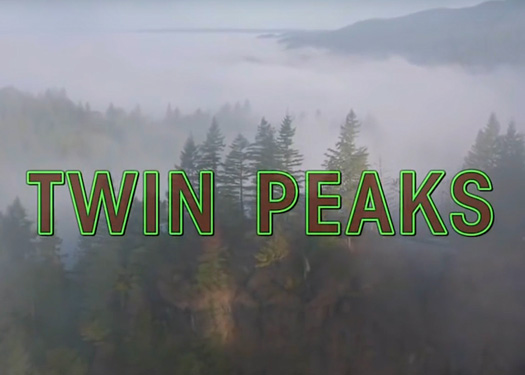
Anything related to Lynch or Twin Peaks always has a certain aura of mysticism surrounding it. So when news dropped that Twin Peaks was greenlit for a third season twenty-five years after Laura Palmer uttered her last words “I’ll see you in twenty-five years,” excitement blew up across the world.
Film and television are businesses that are too hard to judge, to hard to label and put dates on. There is too much detritus between beginning a project and getting clearance to go ahead and do it. For Twin Peaks to come back technically twenty-six years later is weirder than weird after the show’s cancellation. Nobody, not even the best analysts in the world, could of put a date on a show like Twin Peaks getting its revival. Even further, the show was lost to most people’s minds in the mainstream. While it did garner a significant cult following, it never hit the highs that it had for its first episode. Essentially you had a plot that most everyone had long since forgotten about. To most fans, Cooper was doomed to sitting in that waiting room forever with the midget and Laura, while Bob was outside killing again in the guise of Cooper. That was it, a semi-satisfactory ending.
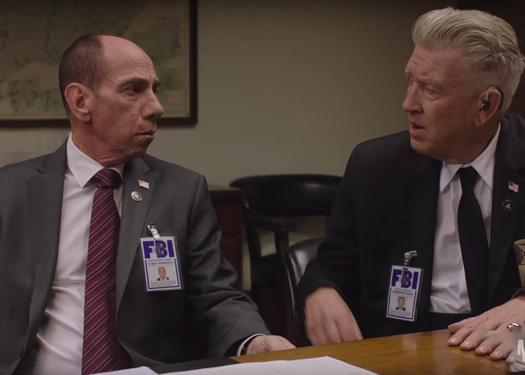 Until it happened again. “Weird things happen around David….” Sherilyn Fenn once said in an interview. Well, weird things happen around his works too.
Until it happened again. “Weird things happen around David….” Sherilyn Fenn once said in an interview. Well, weird things happen around his works too.
Frost and Lynch began writing a script that allegedly took four whole years to get right. Shooting began almost immediately afterward. The sets had to be returned to the exact way they were twenty-five years prior. The police station was remodeled to look as it once did in the early nineties. David even sported the same hat he wore while directing. Almost all the surviving cast members reprised their roles respectively. All scripts were handed out on the day of filming and quickly shredded after the cameras stopped rolling.
The marketing around Twin Peaks: The Return had as much mystery as the original series up until the day it launched. Everyone was pretty much clueless to any plot whatsoever. Just tweets and billboards with “It’s happening again..” scrawled across them in an almost daring and threatening manner.
During the years before season three, Lynch had floated from passion project to passion project. The man was an almost god-like director making the movies no one could understand. He made movies for himself like Lost Highway, Inland Empire, and Mulholland Drive. While they did achieve moderate success critically, they weren’t meant for mainstream consumption they were the meanderings of Lynch’s caffeine-riddled mind. Twin Peaks returning to TV was something for everyone and David Lynch had a lot on his mind he wanted to express.
A monochrome opening and a beautifully revealing sweep of Cooper sitting as he did before, staring into the distance in the red room. Lynch drops some immediate exposition and then Twin Peaks presents itself for the new age. It seeps into your mind and caresses it with dark morbidity. The cold feelings of the uncanny, jilted wrong world. The intro plays the same as it once did, but from different angles. The first episode escalates quickly. We see the sex, violence, and horror of Twin Peaks brought forward twenty-five years. Nothing is as it seems and nothing will be the same.
It is very apparent right at the start of the beautifully immersive scenes Lynch isn’t all too happy with us. We observe a young man who sits on a sofa, in a room protected by security, in a high rise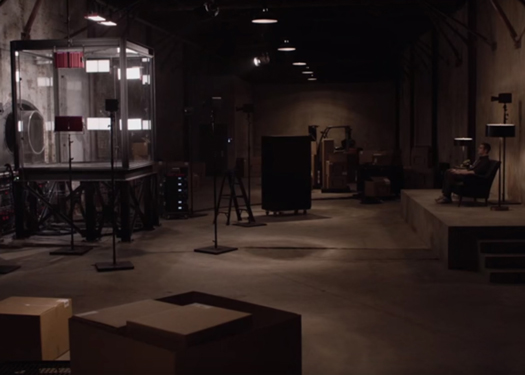 building in New York, look onward at a glass cube with cameras pointed at every possible angle. His job is to sit there day in and day out, changing the film and hard drives in the equipment. He does this repeatedly. His job is to observe, and he does. All day and all night. Until he has a female caller who brings him coffee while the security guard was away. She asks if she can sit with him to see what it is he does. They both sit awkward and expressionless staring absentmindedly at this glass cube. The two then begin to flirt and not long after, have sex in front of the glass cube. Then, some being appears in the cube beating at the glass before breaking through and ripping the two to shreds in a grizzly manner.
building in New York, look onward at a glass cube with cameras pointed at every possible angle. His job is to sit there day in and day out, changing the film and hard drives in the equipment. He does this repeatedly. His job is to observe, and he does. All day and all night. Until he has a female caller who brings him coffee while the security guard was away. She asks if she can sit with him to see what it is he does. They both sit awkward and expressionless staring absentmindedly at this glass cube. The two then begin to flirt and not long after, have sex in front of the glass cube. Then, some being appears in the cube beating at the glass before breaking through and ripping the two to shreds in a grizzly manner.
This can be interpreted one of two ways or even both ways if you have comfort with metaphor. What happened in the scene happens almost every day (apart from the monster tearing people to pieces). If someone has a casual sexual encounter, part of the modern mating ritual involves going over to someone’s apartment watching Netflix to desaturate the awkwardness prior to the act. This ritualistic use of media is notably a frustration for Lynch. To him, I think we are the people on the couch. Day in day out, watching nothing on a glass cube, taking nothing in, and using it as a brain-dead excuse for love in the most unimaginative way. On the other hand, the monster that came through is a conical being in the series. On his way back to our world, Cooper even makes a stop off here and the unknown billionaire who funds the project has been hinted at before.
To achieve that kind of storytelling is quite hard when you think of even more recent movies that have failed on that level (an example being Bright). There are layers to Twin Peaks that no other show has ever had before. Even plot-wise, Cooper’s story picks up right where it left off.
After a certain adjustment period, Lynch knows what we want and he will give it to us, but first, he is going to play with our expectations.
The Cooper walking around for the last twenty-five years is killer Bob. A doppelganger of Cooper who does everything in his power to show us how much of a badass he is and also how much of an evil person he is through some very disturbing murder scenes. We also find out later this guy is a serial rapist. He is evil personified.
Perhaps the most frustrating part of Twin Peaks: The Return is the chasing of the pipe dream that we will see good old Coop again. We see Coop at the beginning. The good huggable Coop. We won’t be seeing this guy again for about sixteen episodes. Instead, we get a guy known as Dougie. A person who is identical to Cooper in image only. When Cooper came back to our world he replaced his second doppelganger Dougie and is easily mistaken for him. But Cooper lost more than his identity on his voyage from the Black Lodge. He is in a state of shock, trying to reboot back to the Cooper we once knew. So, for the time being, he is essentially Dougie, a mumbling idiot with a heart of gold.
On my first viewing, I hated this. I wanted Coop! I get this moron instead?
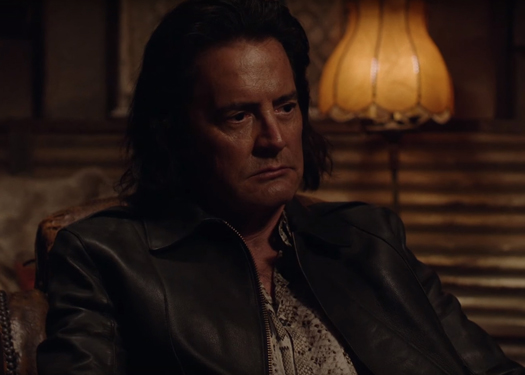 On my second viewing, I realized Lynch knows you want Cooper. You want Cooper the same way you wanted to know who killed Laura Palmer. I began to love what Lynch had done. On paper, it is the story of Cooper’s odyssey back to the town of Twin Peaks. Now how would David Lynch, the man who never tells a straight story (except for that one movie he made called The Straight Story), tell this story? If it had been what we wanted, essentially two Coopers duking it out in Twin Peaks, the show would be four episodes long. So instead we have Dougie and we watch as the almost catatonic Cooper learns to do everything again (including using the bathroom). Inside we can see the old Cooper smashing against the windows of his soul screaming to get out. When we see Cooper sip his first coffee and see a certain glint of recollection, our hearts skip a beat. When the movie on TV gets Coop’s attention by the character saying “Get me Gordon Cole,” we see Coopers eye’s light up and we know he’s in there.
On my second viewing, I realized Lynch knows you want Cooper. You want Cooper the same way you wanted to know who killed Laura Palmer. I began to love what Lynch had done. On paper, it is the story of Cooper’s odyssey back to the town of Twin Peaks. Now how would David Lynch, the man who never tells a straight story (except for that one movie he made called The Straight Story), tell this story? If it had been what we wanted, essentially two Coopers duking it out in Twin Peaks, the show would be four episodes long. So instead we have Dougie and we watch as the almost catatonic Cooper learns to do everything again (including using the bathroom). Inside we can see the old Cooper smashing against the windows of his soul screaming to get out. When we see Cooper sip his first coffee and see a certain glint of recollection, our hearts skip a beat. When the movie on TV gets Coop’s attention by the character saying “Get me Gordon Cole,” we see Coopers eye’s light up and we know he’s in there.
The fascinating and most gripping thing about all of this is with any other director we know that by the end we will get what we want, but with David Lynch, we never are that confident. He might just give us Dougie and we may never see the Cooper we know and love. By the last episode, we are not very sure who Cooper even is anymore.
Lynch plays up the uncomfortable horror elements of Twin Peaks this time around. Showing his true artistry. One of the most unsettling of scenes is when bad Cooper goes to visit Phillip “The Coffee Pot” Jeffries. As we follow bad Cooper through the voyage of doors, a certain transition between worlds is made by showing you the most beautiful camera work and we are situated behind him the whole way. Lynch’s eye for cinema is shown here perfectly. Prior to this, he was always the director who is “…an artist first and doesn’t do the whole plot thing. He wouldn’t be even interested in making an action scene or a cinematic scene. The kind of stuff that Scorsese or Spielberg do. That kinda cinema, it just isn’t him,” I would say, but after seeing this, it’s clearly evident he can indeed do anything you throw at him.
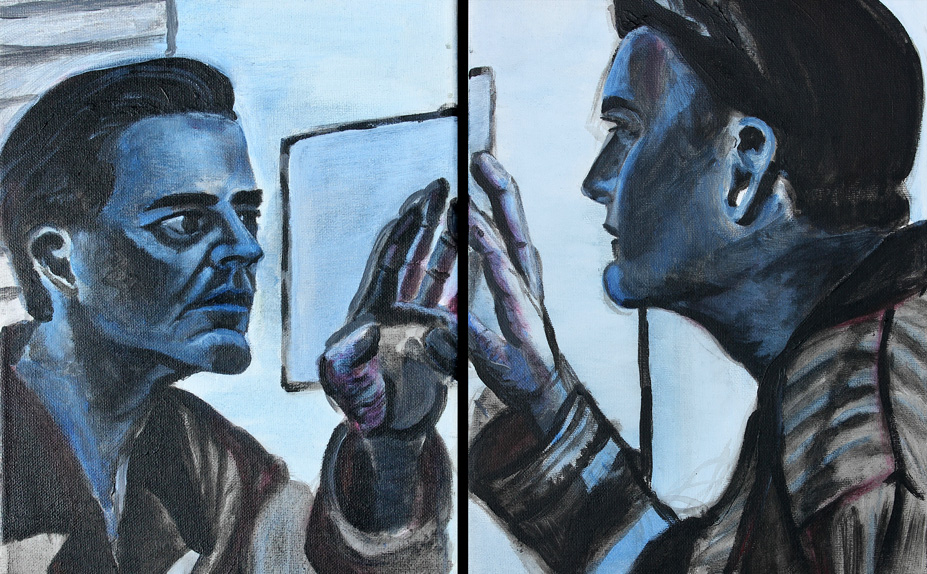
You would indeed be forgiven for thinking you wouldn’t get any more insight into Twin Peaks and probably no solid answers in season three. Even I thought that by the time the credits roll I will be none the wiser to any element of Twin Peaks. I and most every other fan I would wager were merely surprised by the fact it gave us all the answers at least one in each episode. Even a particular episode gives you an enigmatic, yet not too hard to decipher, origin story of how everything came to be. Gordon Cole would even later flesh out the area of the FBI he and his team inhabit. This did come as a surprise, as the plot moves forward some things at the beginning that are seemingly going nowhere (the original series was guilty of following thread that would eventually go nowhere) always ended up coming full circle by the second to last episode. Aside from one or two mysteries, everything is tied up in a neat little bow. Even the Log Lady (Catherine E. Coulson) had her arc and tragically her life, come to an end. Catherine E. Coulson was indeed dying during filming and somehow David Lynch brought that into the plot and gave her a simple yet utterly beautiful eulogy in her last performance. She speaks over the phone to Deputy Hawk (Michael Horse) in a tone of voice and line delivery that cannot be acted, but is so believable because the actress was indeed on her deathbed staring into the void. She read her line’s one last time a very simple yet poignant few phrases “Hawk………. I’m dying………” the long pause as she chokes back the tears “You know about Death. It’s just a change, not an end…” she says as her tone reaches a higher more light pitch “Hawk… It’s time… There is some fear…. some fear in letting go….” For Lynch to be daring enough and brave enough to attempt such a thing in a television show is proof that he didn’t think once about how such a scene would go down with anyone else. He was doing this for himself and everyone who loved Twin Peaks. A true sign of an artist and a heartwarming goodbye from the actress.
Season three, has that very Lynch/Frost feel. The perfect hurricane of creative artistry combined with storytelling and character building that melds together beautifully like Jazz. It grows within its own insanity,
Lynch and Frost wrapped everything up in the season’s penultimate episode. All the twenty-five-year-old questions had gotten their answers. All the characters were brought full circle and then… Well, I’d rather not spoil the ending, but by the end of the very last episode your left saying “What? What the hell just happened?” A whole new mystery that perhaps we will learn where this new branching arc goes within four years instead of twenty-five.
After finishing everything within this season, David Lynch has removed himself from film to pursue other spiritual projects (as of 2018 this is his latest project). His narrative construction and direction are as bold and confident as they have ever been. Both the writing and content of the story is rebellious for television, but it is unapologetically David Lynch and the Twin Peaks he wanted to deliver.
Leave a Reply